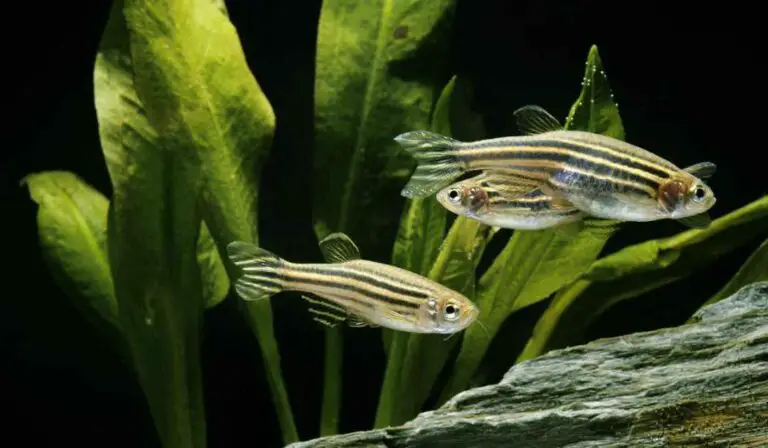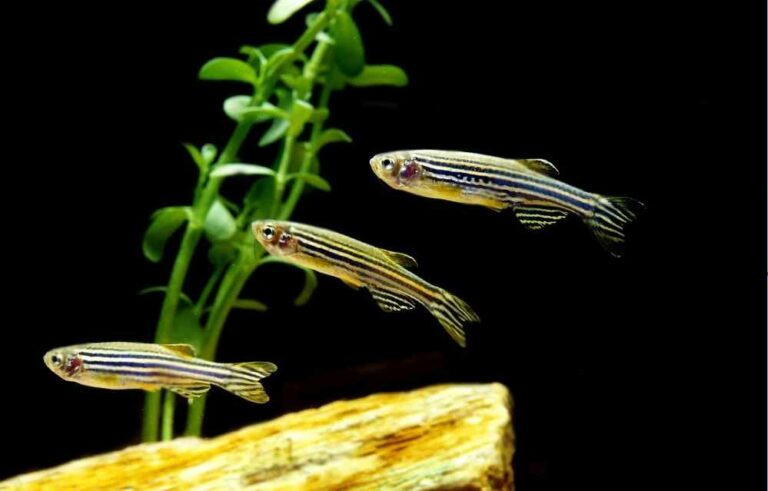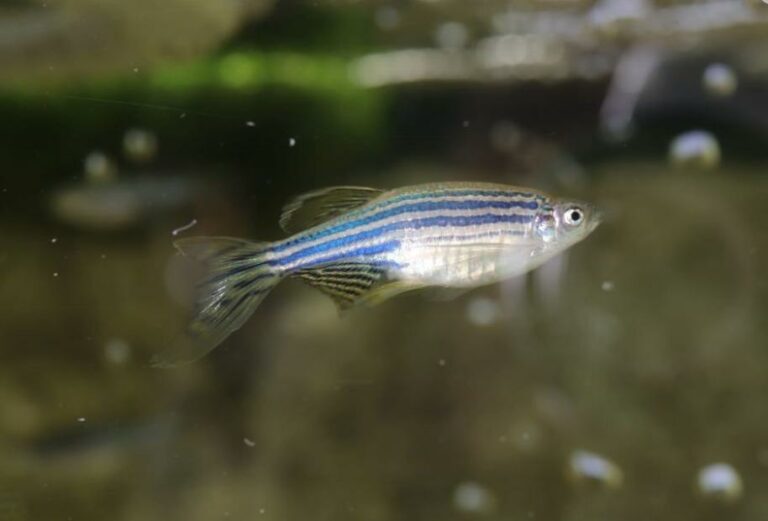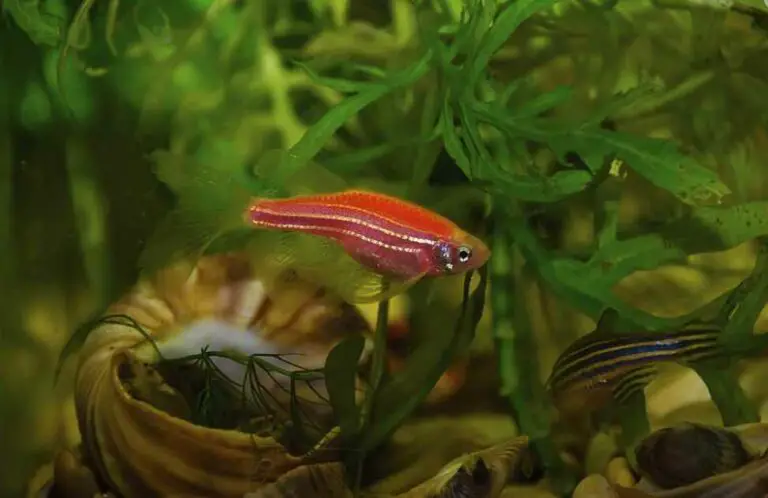Maximizing the Lifespan of Your Zebra Danio Fish: 10 Key Factors
As a Zebra Danio fish owner, you want your vibrant buddy to live a long and healthy life. The average lifespan of a Zebra Danio fish is 3-5 years, but with proper care, these fish can live up to 5-10 years. By optimizing your Zebra Danio’s environment and care regimen, you can help extend its lifespan.
With the proper environment, nutrition, and care, your Zebra Danio can thrive! Aim for pristine water, a varied diet, swimming space, and a low-stress tank. Here are the 10 most crucial factors.
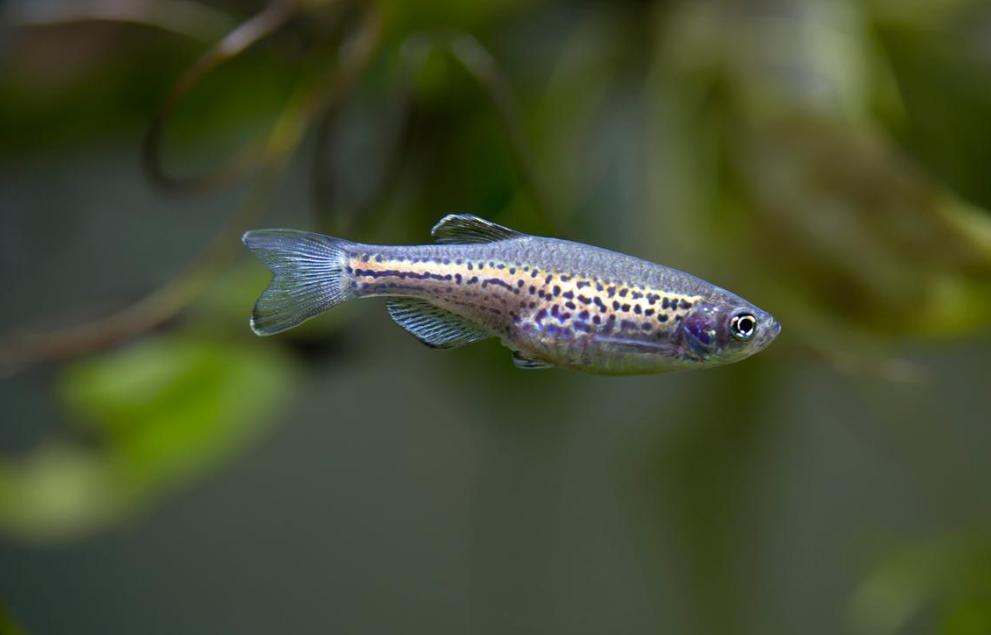
Table of Contents
- 01. Water Quality
- 02. Temperature
- 03. Diet and Feeding
- 04. Stress
- 05. Tank Size and Environment
- 06. Genetics
- 07. Parasites and Disease
- 08. Maintenance Routine
- 09. Proper Acclimation
- 10. Breeding Practices
- Key points about Danio fish lifespan
01. Water Quality
Water quality is the most crucial factor affecting a Zebra Danio fish’s lifespan. Ideal water parameters closely mimic their natural habitat:
- pH Level:
Zebra Danios thrive in slightly acidic to neutral pH between 6.5 and 7.5. Values outside this range can negatively impact their health.
- Ammonia:
This compound is highly toxic and should always be kept at 0 ppm in the tank. Excess ammonia can burn gills and reduce lifespan.
- Nitrates:
Levels above 20 ppm are unsafe. Aim to keep nitrates below 10 ppm, performing water changes as needed. High nitrates make fish prone to disease.
- Nitrites:
Another dangerous substance that should be 0 ppm. Exposure can hinder growth and damage organs.
- General Hardness (GH):
Maintain 3-4 dGH (50-70 ppm). Soft water between 4-5 dGH is ideal.
- Carbonate Hardness (KH):
Levels from 2-5 dKH (35-90 ppm) are recommended. This influences pH stability.
A good filtration system, plant growth, and regular partial water changes all help maintain safe water parameter levels. Sudden changes in water chemistry can shock Zebra Danio fish, so always acclimate fish slowly when introduced to new tanks. Proper ongoing water testing and management plays a major role in your Zebra Danio’s health and lifespan.
Read more details on the importance of proper water temperature for Zebra Danio fish below.
02. Temperature
As tropical fish, Zebra Danios require warm water temperatures within a specific range to thrive. Water temperature is a key environmental factor impacting their lifespan.
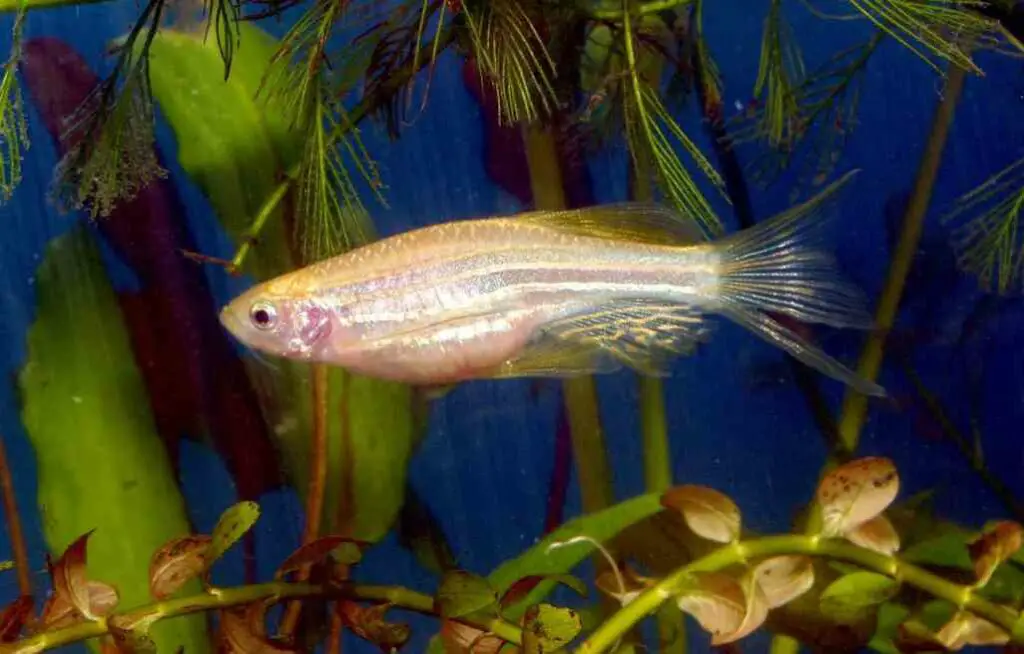
- The ideal range is 76-82°F (24-28°C). Temperatures below 74°F (23°C) can lead to lethargy and illness.
- Use an adjustable aquarium heater and thermometer to maintain a consistent temperature. Fluctuations above or below the ideal range cause stress.
- Too cold water slows the metabolism, weakens the immune system, and promotes fungal infections.
- Overly hot water accelerates metabolic rate, leading to a shorter lifespan. It also decreases oxygen saturation.
- Whenever adjusting temperature, increase or decrease no more than 2°F (1°C) per hour. This allows fish to acclimate to avoid shock.
- Monitor fish closely when introducing them to a new tank. Only release into the tank after equalizing the temperature slowly over a few hours.
Stable, warm water in their ideal temperature range is critical for a Zebra Danio’s health and longevity. Invest in proper heating tools and be vigilant about monitoring the temperature daily. Gradual acclimation gives fish time to adjust to new environments.
www.tinyfishtank.com
Here is an expanded section on diet and feeding practices for optimal Zebra Danio lifespan.
03. Diet and Feeding
A nutritious diet is crucial for your Zebra Danio’s health and longevity. As carnivores, they require high-protein foods.
Feed a high-quality Zebra Danio pellet 2-3 times daily as the staple diet. Pellets specifically formulated for Zebra Danios provide complete nutrition.
Supplement with frozen or live foods like bloodworms, brine shrimp, and daphnia 2-3 times per week. This adds variety and enrichment. Only feed amounts that can be fully consumed within 2 minutes. Overfeeding leads to waste buildup and obesity.
Avoid cheap pellet brands that use fillers instead of quality protein sources. Low nutrition can shorten lifespan. Do not feed Zebra Danio flakes, as Zebra Danios often miss and do not swallow flakes, leading to waste.
Refrain from feeding freeze-dried foods like bloodworms too often, which can cause bloating.
- Do not feed foods made for other fish, like goldfish. Zebra Danio-specific diets meet their unique nutritional requirements.
- Fast your Zebra Danio for 1 day per week to support digestion and prevent constipation.
Proper, nutritious feeding practices can promote good health and extend Zebra Danio’s lifespan. Monitor growth and adjust feeding amounts as needed. A balanced Zebra Danio diet fuels a long, vibrant life.
Ensure to feed enough food for your fish tank; otherwise, they will start fighting, which will stress your fish.
04. Stress
Stress is detrimental to a Zebra Danio’s health and can significantly shorten its lifespan if chronic. Zebra Danios are prone to stress from environmental factors, including:
- Overcrowding – Zebra Danios are territorial and should be kept 1 per tank. Even tankmates like fish or shrimp can trigger aggression and stress.
- Abrupt water parameter changes – Temperature, pH, and hardness fluctuations outside their preferred ranges induce stress. Changes should always be gradual.
- Exposure to loud noises – Consistent loud ambient noise from TVs, radios, or filters can stress Zebra Danios over time.
- Insufficient places to hide – Plenty of plants and caves reduce stress by allowing them to hide when needed.
- Inadequate tank space – The minimum tank size is 5 gallons, but larger is less confining.
- Harassment from other fish – Nippy species may attack fins/ tails, causing stress.
- Improper handling – Netting or moving fish to new tanks should be delicate to avoid injury.
Chronic stress suppresses the immune system, makes Zebra Danios prone to disease, and can manifest in lethargy/loss of appetite. Minimizing stress by optimizing the tank environment and water parameters is critical. Keep handling gentle and allow time to acclimate to any changes. Reduced stress promotes longevity.
Sometimes, stress also depends on the tank size. Here are more details on the ideal tank size and setup for Zebra Danios.
05. Tank Size and Environment
The tank size and overall setup have a major influence on Zebra Danios’ health and longevity.
- The minimum tank size is 5 gallons (20 liters), but larger is ideal – aim for 10+ gallons (40+ liters).
- Bigger tanks allow for more stable water parameters and less waste accumulation.
- More surface area gives them adequate room to swim and exercise. Zebra Danios are active fish.
- Include live or silk plants for security, visual barriers, and enriching exploration.
- Incorporate caves, driftwood, rocks, etc., to create a complex environment.
- Place the tank out of direct sunlight and away from drafts.
- Filter flow should be low and avoid heavy currents that stress fish.
- The substrate should be smooth gravel or sand to prevent fin tearing.
An appropriately sized, enriched tank with hiding spots and appropriate conditions reduces stress and promotes general health and longevity. While Zebra Danios can survive in small containers, their lifespan is maximized in larger, engaging environments that meet their natural behaviors.
06. Genetics
A Zebra Danio fish’s genetics significantly influence its health and longevity potential. Zebra Danios have been selectively bred for traits like color, finnage, and aggression. However, extensive breeding has weakened gene pools in some Zebra Danio populations.
- Zebra Danios from reputable breeders often have greater genetic diversity and strength. These fish tend to live longer, healthier lives.
- Pet store Zebra Danios usually come from fish farms focused on quantity over health/longevity. Inbreeding is common. These fish are more prone to illness.
- Zebra Danios, with shorter fins, tend to be hardier and live longer than long-finned show Zebra Danios, especially males.
- Giants Zebra Danios with accelerated growth often have shorter lifespans, around 2-3 years.
While you can’t change your Zebra Danio’s inherent genetics, choosing healthy stock improves the odds. Seek active fish from sellers focusing on health rather than flashy fins and colors. Robust genetics combined with proper care helps Zebra Danios reach the upper end of their lifespan range. However, any Zebra Danio can live better in a nurturing environment despite genetic odds.
07. Parasites and Disease
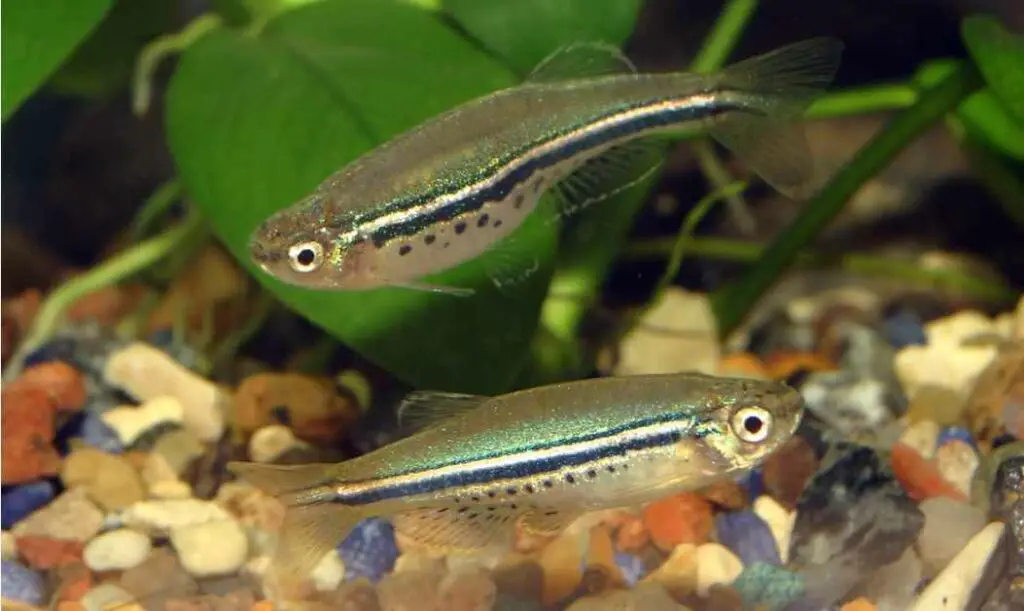
If left untreated, parasites and infectious diseases threaten a Zebra Danio’s health and longevity. Some common issues include:
- Ich (Ichthyophthirius multifiliis) – A highly contagious parasite that causes white spots, fraying fins, and scratching. It can be fatal.
- Velvet – Skin infection giving a yellow-gold dusty appearance. Loss of appetite and lethargy often occur.
- Fin rot – Bacterial infection eating away at fins. Causes fraying/rotting. It spreads rapidly, so prompt treatment is needed.
- Columnaris – Another aggressive bacterial disease leading to lesions, mouth fungus, and decay. Requires antibiotics.
- Intestinal parasites – Can cause constipation, bloating, abnormal swimming, and emaciation over time.
- Fungal infections – Displayed as cotton-like growths on skin and fins. Reduce immune function.
Prevent parasites by quarantining new fish and plants before adding them to the tank. Notice early signs like clamped fins or scratching. Use aquarium salt, anti-parasitic meds, or antibiotics as directed immediately at the first onset of the disease. Maintain excellent water quality. With prompt care, fish can recover from many parasitic and bacterial illnesses, allowing an average lifespan.
08. Maintenance Routine
Consistent tank maintenance and cleaning are vital to a Zebra Danio’s health and longevity. Key elements of a maintenance routine include:
- Weekly partial water changes of 25-50% using a gravel vacuum to remove waste from the substrate. This replenishes fresh, clean water.
- Testing water 1-2 times per week with liquid test kits. Monitor levels of ammonia, nitrites, nitrates, pH, and hardness.
- Filter media should be swished/rinsed in old tank water every 2-4 weeks. Avoid replacing filter cartridges to maintain beneficial bacteria.
- Wipe down tank walls with an aquarium-safe algae scrubber to prevent buildup. Never use soap.
- Inspect plants for decay remove and replace when necessary. Prune to maintain optimal growth.
- Check decor for accumulated gunk, scrub with old tank water, and brush to clean. Replace worn ornaments.
- Siphon waste from gravel or stir sand substrate weekly to prevent toxic gas pockets.
- Quarantine new fish/plants for 2-4 weeks before introducing them to the main tank.
With a proper maintenance regimen, you can optimize water quality and cleanliness. This boosts immunity against disease and contamination, keeping your Zebra Danio happy and healthy for years.
09. Proper Acclimation
Gradual acclimation is vital when moving Zebra Danios to a new tank or introducing tankmates. It prevents shock from sudden water parameter changes that can shorten lifespan. Follow these steps:
- Allow the bag with fish to float in the new tank for 15 minutes. This equalizes temperature.
- Add small amounts of fresh tank water to the bag over 30-60 minutes. Add 1 tablespoon every 5 minutes.
- After 60 minutes, discard half the bag of water. Add another tablespoon of new water every 5 minutes for 30 mins.
- Using a net, gently release Zebra Danio into the new tank after 90-120 minutes.
- Keep lights dimmed for the first few hours to reduce stress further.
- Consider using a drip acclimator, if available, to slowly add new water over several hours.
- Monitor your Zebra Danio closely after the introduction. Watch for signs of stress, like clamped fins.
- Allow at least a week to adjust before changing decor or tank settings.
Proper acclimation prevents osmotic shock and helps fish safely transition to new environments. Take it slow and steady to give your Zebra Danio the best chance to thrive in its new home.
10. Breeding Practices
Breeding practices directly impact the health and longevity of Zebra Danio offspring. Unethical breeding can reduce lifespan:
- Inbreeding to reinforce desired traits results in a limited gene pool. This increases the risk of genetic abnormalities and illness.
- Selective breeding for long fins or unnatural colors often comes at the expense of vitality and lifespan.
- Breeding at too young an age before full maturity results in weaker fry. Wait until 4-12 months for optimal offspring health.
- Allow 4-8 weeks between spawning cycles to avoid exhausting the breeding pair. Females should be retired after 6-8 spawnings.
- Cull fry with noticeable defects. Only keep the strongest individuals to continue breeding lines.
Ethical practices involve diverse gene pools, selective culling, appropriate breeding ages, and rest between cycles. Seek breeders who value health and longevity overlooks alone. Robust genetics and vitality early in life carry through, supporting longer lives. While color and finnage have been prioritized historically in Zebra Danios, the focus is shifting to creating heartier, healthier fish.
Key points about Danio fish lifespan
Danio fish can live 3-5 years on average in the wild, with longevity affected by water conditions, temperature, food availability, predators, and competition. With optimized home aquarium care, including high water quality, proper temperature, a varied diet, an adequately sized tank, enrichment, and disease prevention, danios typically survive 3-6 years.
Still, some may exceed 6 years in captivity. Their lifespan is extended by replicating ideal environmental conditions and providing proactive fish health management. Proper care helps Danios thrive long-term.
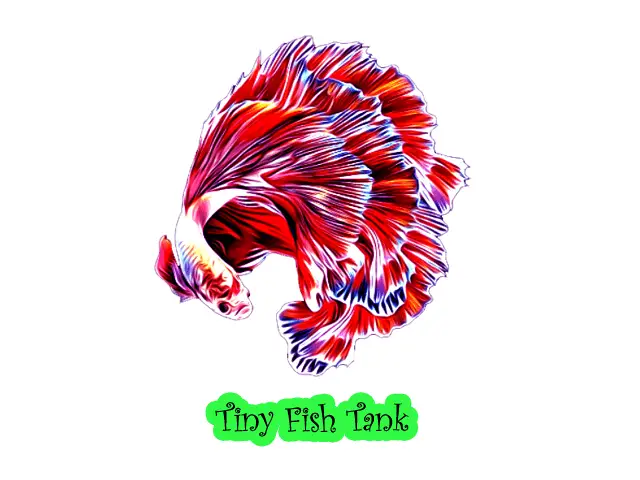
![The Dangers of Housing Zebra Danio with Guppy Fry [Risks & 6 Solutions]](https://www.tinyfishtank.com/wp-content/uploads/2023/08/Zebra-Danio-with-Guppy-Fry.jpg)
![The Curious Case of the Disappearing Zebra Danios [5 facts]](https://www.tinyfishtank.com/wp-content/uploads/2023/08/Disappearing-Zebra-Danios-768x458.jpg)
